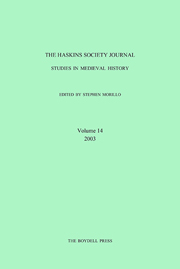Book contents
- Frontmatter
- Contents
- List of Illustrations
- Editorial Note
- Abbreviations
- 1 Even the Devil (Sometimes) has Feelings: Emotional Communities in the Early Middle Ages
- 2 Alcuin, Willibrord, and the Cultivation of Faith
- 3 Henry Loyn Memorial Lecture: English Identity from Bede to the Millennium
- 4 The ‘Farm of One Night’ and the Organisation of Royal Estates in Late Anglo-Saxon Wessex
- 5 Changing Fortunes: Edwardian Anglo-Jewry and their Credit Operations in Late Thirteenth-Century England
- 6 Forty Acres and a Mule: the Mechanics of English Settlement in Northeast Wales after the Edwardian Conquest
- 7 Consanguinity and the Saint-Aubin Genealogies
- 8 Widows, Religious Patronage and Family Identity: Some Cases from Twelfth-Century Yorkshire
- 9 Desecration and Consecration in Norman Capua, 1062–1122: Contesting Sacred Space during the Gregorian Reforms
- 10 From Ego to Imago: Mediation and Agency in Medieval France (1000–1250)
1 - Even the Devil (Sometimes) has Feelings: Emotional Communities in the Early Middle Ages
Published online by Cambridge University Press: 05 September 2014
- Frontmatter
- Contents
- List of Illustrations
- Editorial Note
- Abbreviations
- 1 Even the Devil (Sometimes) has Feelings: Emotional Communities in the Early Middle Ages
- 2 Alcuin, Willibrord, and the Cultivation of Faith
- 3 Henry Loyn Memorial Lecture: English Identity from Bede to the Millennium
- 4 The ‘Farm of One Night’ and the Organisation of Royal Estates in Late Anglo-Saxon Wessex
- 5 Changing Fortunes: Edwardian Anglo-Jewry and their Credit Operations in Late Thirteenth-Century England
- 6 Forty Acres and a Mule: the Mechanics of English Settlement in Northeast Wales after the Edwardian Conquest
- 7 Consanguinity and the Saint-Aubin Genealogies
- 8 Widows, Religious Patronage and Family Identity: Some Cases from Twelfth-Century Yorkshire
- 9 Desecration and Consecration in Norman Capua, 1062–1122: Contesting Sacred Space during the Gregorian Reforms
- 10 From Ego to Imago: Mediation and Agency in Medieval France (1000–1250)
Summary
According to the Burgher of Paris, everyone in the processions at Paris in 1412 ‘cried a lot and shed a lot of tears.’ The chronicler Georges Chastellain reported that a criminal being put to death talked to the on-lookers, ‘and he so touched their hearts that all burst into tears of compassion.’ During the funeral procession of Charles VII, says the Journal de Jean de Roye, the courtiers, were ‘all dressed in the deepest mourning, which made them very pitiful to see, and because of the great sorrow and grief that they showed for the death of their master, tears were shed and lamentations made by all in that city.’ Nor were there just floods of tears in these sorts of accounts: princes, in Chastellain's view, were ‘subject to many passions, such as hatred and envy, … and their hearts are veritable dwelling places of such things.’ And thus Philip the Good, according to Chastellain, ‘would devote himself to avenging the dead in the most violent and deadly rage (aigreur).’
These and similar passages helped Johan Huizinga illustrate a major thesis of his 1919 publication Herfsttij der Middeleeuwen: that, for all its decadence, the late Middle Ages nevertheless continued to represent the innocent childhood of modern man.
- Type
- Chapter
- Information
- The Haskins Society Journal 142003. Studies in Medieval History, pp. 1 - 14Publisher: Boydell & BrewerPrint publication year: 2005



